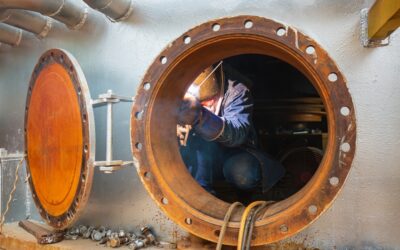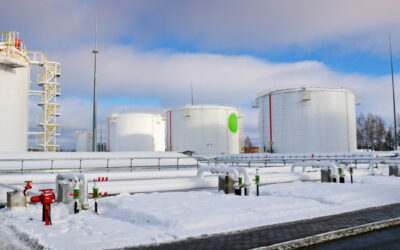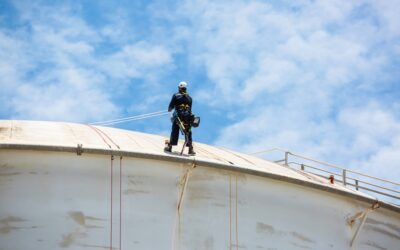Rubber lining is a key material that protects industrial tanks against abrasive materials and chemical corrosion. Not only does it extend the life of tanks but it also enhances their performance, reduces maintenance costs, and ensures safety. However, rubber lining is only effective if installed properly by an experienced contractor.
As a leader in the field, we’re committed to a meticulous rubber lining installation and rigorous inspection process. (Because installation mistakes and challenges can happen! Read about them here.)
How Rubber Lining Is Installed:
Below is a step-by-step walkthrough of how rubber lining is applied.
1. Assess Site Conditions & Tank
The first step in any rubber lining installation project is a thorough assessment of the site conditions and an understanding of the unique needs of the tank or vessel. The type of material the tank will store, the temperature and pressure conditions it will encounter, and any other environmental factors that could affect the performance of the rubber lining must be evaluated.
Other key things to consider include:
- Material compatibility: The type of rubber lining material chosen must be compatible with the tank’s contents (e.g. chemical-resistant rubber is essential for tanks storing acidic or alkaline solutions).
- Environmental conditions: Factors like temperature fluctuations, UV exposure, and moisture levels must also be considered while choosing a rubber lining material and determining installation best practices.
2. Select the Right Rubber Lining Material
Once the site conditions are assessed, the next step is to use that information to select the appropriate rubber lining material.
Common Rubber Lining Materials
Just a few of the most common types of rubber used for rubber lining are:
- Natural rubber, known for its elasticity and resilience, is suitable for abrasive environments.
- Neoprene rubber offers resistance to oils, chemicals, and weathering.
- EPDM rubber is ideal for high-temperature applications and is resistant to steam and weathering.
- Butyl rubber is highly impermeable to gases and used in chemical-resistant applications.
This is not an exhaustive list, and there are many other types of rubber options. The ultimate choice is dependent on a discussion between us, the contractor, and the client and includes factors like material qualities, cost, and availability.
3. Prepare the Tank Surface for Rubber Lining
A well-prepared surface ensures proper adhesion of the rubber lining, which in turn prevents potential failures and extends the life of the coating.
The steps include:
- Cleaning: The tank surface must be thoroughly cleaned to remove any contaminants, rust, or old coatings. This is typically done using abrasive blasting techniques like sandblasting.
- Roughening: The surface is then roughened to create a texture that promotes better adhesion of the rubber lining, also completed with abrasive blasting techniques.
- Priming: A primer is applied to the prepared surface to further enhance adhesion. The type of primer used depends on the rubber lining material selected.
4. Apply the Rubber Lining
This step requires the highest amount of precision and expertise because uniform coverage and adherence are critical. Two main application methods can be used depending on the material and project specifications.
- Hand laying, which involves manually applying rubber sheets to the surface. This method is ideal for complex shapes and detailed areas.
- Spray coating, where liquid rubber is sprayed onto the surface and provides a seamless and uniform coating. This method is faster, but not always feasible in complex projects.
5. Cure the Rubber Lining
Rubber lining undergoes the vulcanization process, where it is cured using heat and pressure. This process involves mixing crude rubber with 5-30% sulfur or another similar agent to create cross-links between the polymer chains. The chemical reactions enhance the material’s durability, chemical resistance, and temperature resistance.
In some cases, the rubber lining is applied before it is applied to the tank (before step 4). This is where you’ll hear about cured vs. uncured rubber.
Cured vs. Uncured Rubber Lining
You can read more about cured vs. uncured rubber and their coinciding pros and cons in this article, but here’s a quick rundown:
Cured rubber undergoes vulcanization before the installation process, which increases its durability, chemical resistance, and temperature resistance beforehand. However, the cured rubber can make for a more difficult and time-consuming installation. It can also make repairs more frequent and difficult.
Uncured rubber is first applied to the tank surface and then undergoes vulcanization. This method allows for more flexibility and repairability during the installation process. However, it will still need to be vulcanized (cured) afterward and will have a lower initial strength before that can take place.
6. Complete Inspection & Quality Assurance Protocol
The final step in the rubber lining installation process is a thorough inspection to ensure that the lining has been applied correctly and meets all quality standards. This step is crucial to identify any defects or areas that may require additional attention before the tank or vessel is put into service.
What’s Involved in Inspection & QA
At US RUBBER, we pride ourselves on two main commitments: safety and quality. In fact, our rubber lining specialists are National Association of Corrosion Engineers (NACE) certified inspectors. We ensure all rubber lining projects are highly functional and comply with industry standards via:
- Visual inspection: Our technicians visually inspect the entire surface for any signs of defects, such as bubbles, wrinkles, or gaps in the lining.
- Spark testing: A high-voltage spark tester is used to detect pinholes or voids in the rubber lining that may not be visible to the naked eye.
- Adhesion testing: The adhesion of the rubber lining to the surface is tested to ensure it meets the required standards.
Until each of those tests is run, we don’t consider the job complete.
For a Rubber Lining Installation Job Well Done, Call Our Experts
Applying rubber lining is a complex process that requires careful planning, expert application, and thorough inspection to ensure the longevity and performance of the lining.
By following these steps, our team delivers high-quality, durable rubber linings that protect industrial tanks and vessels for years. If you’re looking for an experienced team for your project, get in touch with us; we have over 35 years of experience in multiple industrial sectors.







